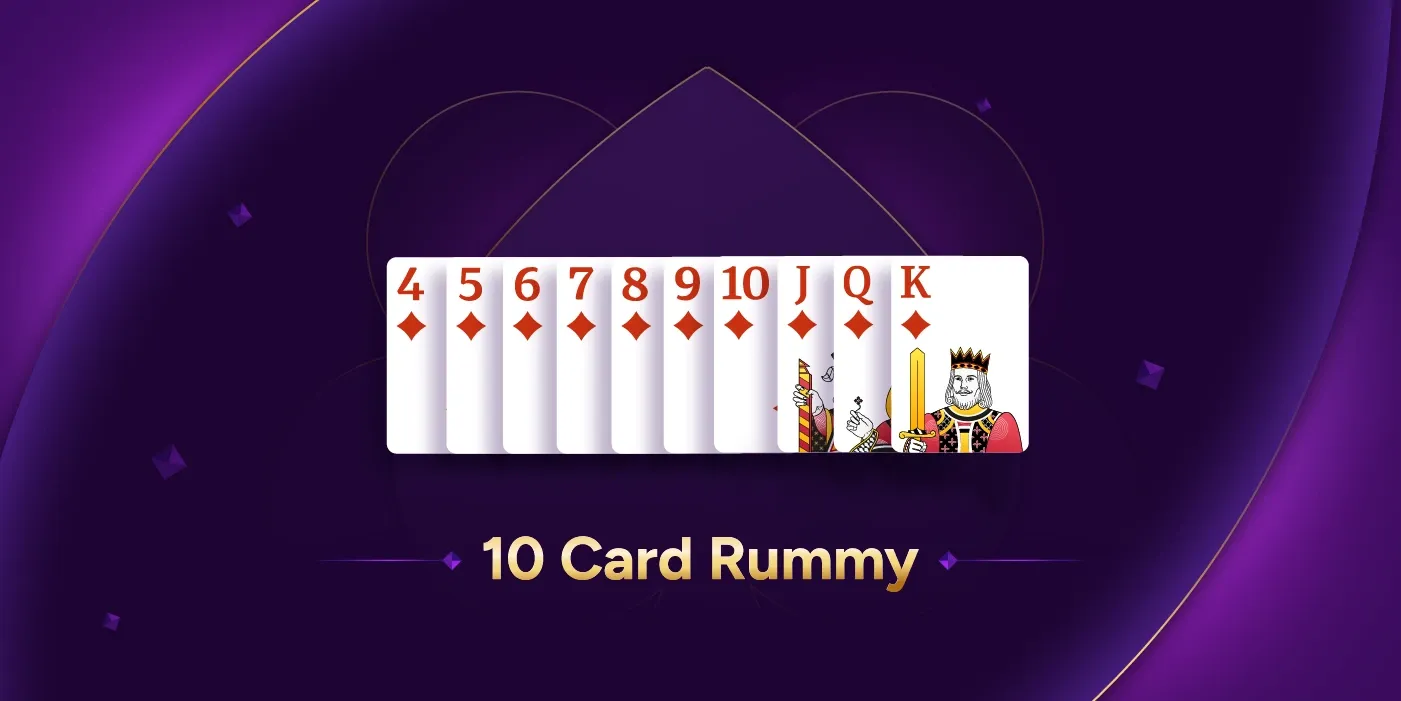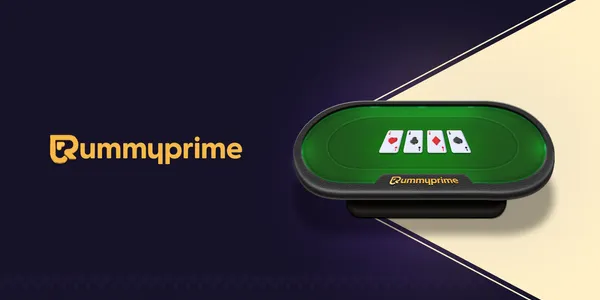- Home
- Did You Know
- 10 Card Rummy Variant in Indian Rummy
10 Card Rummy Variant in Indian Rummy
If you are looking for a fast and engaging game of Rummy, then 10 Card Rummy is your best option. In this variant, you’ll need at least 2 players, and it can go up to 6 players maximum.
Rummyprime Elite Editors | 2nd Apr, 2025

10 Card Rummy
Fast, thrilling, and packed with strategy – 10 Card Rummy is a dynamic twist on traditional 13 Card Rummy. Each player is dealt only 10 cards, making every move crucial. The goal? It is the same as traditional rummy – to make valid sets and sequences before your opponents do.
The key here is quick decision-making, as a pure sequence remains mandatory, just like 13 Card Rummy. This variant is perfect for rummy lovers who enjoy a fast-paced challenge. Though 10 Card Rummy is not available on the Rummyprime app, you can still enjoy this game offline with your friends.
What is 10 Card Rummy?
If you are looking for a fast and engaging game of Rummy, then 10 Card Rummy is your best option. In this variant, you’ll need at least 2 players, and it can go up to 6 players maximum. It is played with two standard decks of 53 cards, and follows the same rules as traditional 13 Card Rummy. The objective is still to make a valid declaration of sets and sequences before your opponent.
Origin of 10 card rummy
10 Card Rummy is a fast-paced variant of traditional Rummy, believed to have originated from the larger family of draw-and-discard card games. While Rummy’s roots trace back to the 19th century, this shorter format gained popularity in India, particularly in online gaming. It follows the same grouping principles but with a quicker gameplay, making it ideal for casual players.
Objective of 10 Card Rummy
The primary objective of 10 Card Rummy is to form valid sets and sequences with all 10 dealt cards before your opponents do. A player must have at least one pure sequence (without a joker card) to declare. The game follows standard Rummy rules, where players pick-and-discard cards to complete their hand while minimizing penalty points.
Basics of 10 Card Rummy
- Number of Players – 10 Card Rummy can be played between 2 to 6 players.
- Decks Used – Two standard decks of 52 cards each, along with printed jokers are used when there are more than 2 players.
- Objective – The goal is to form valid sets and sequences using the 10 cards that are dealt to each player.
- Compulsory Pure Sequence – At least one pure sequence (without a joker card) is mandatory to make a valid declaration.
- Gameplay – Players take turns drawing and discarding cards to complete their sets and sequences.
- Joker Use – Printed and wild jokers can be used to complete sets and sequences, except for the mandatory pure sequence.
- Winning Criteria – A player must make valid combinations and make a valid declaration before other players.
- Points System – Each card carries points based on their face value, and the winner gets zero points, while others receive penalty points based on ungrouped cards.
- Drop and Penalty – Players can drop out early with a small points penalty – first drop incurs 20 points, while dropping out in the middle results in 40 points.
- Scoring – The losing player’s score is calculated based on the ungrouped cards, with a maximum of 80 points in a hand.
How to Play 10 Card Rummy – Rules
In 10 Card Rummy, each player is dealt 10 cards. The game follows a draw and discard format where players:
- Draw one card either from the discard (open) pile or the closed deck.
- Players have to discard one card once they have picked a card, keeping 10 cards in their hands at all times.
Formation of Sets and Sequences:
A sequence is a group of three or more cards of the same suit in consecutive order. There are two types of sequences – Pure sequence is the one made without using a joker, and the impure sequence includes a joker as a substitute for a missing card.
Examples of valid sequences:
- Pure Sequence: ♥5, ♥6, ♥7
- Impure Sequence: ♣8, ♣9, (PJ) (Printed Joker is used to replace ♣10)
A set is a group of three to four cards of the same rank but different suits. Wild Card Jokers or Printed Jokers can be used as substitutes for missing cards.
Examples of valid sets:
- Without Joker: ♦4, ♠4, ♣4
- With Joker: ♥Q, ♠Q, (WJ) (Wild Joker is used to replace ♣Q)
Jokers in 10 Card Rummy:
- Printed Joker (PJ): Always acts as a substitute or replacement card.
- Wild Card Jokers (WJ): A randomly chosen card at the start of the game. (For Example: if 7♠ is chosen, all 7s act as Jokers)
Winning the Game in 10 Card Rummy
In 10 Card Rummy, a valid declaration requires players to arrange all 10 cards into valid sequences and sets before discarding their final card. A valid declaration must include at least one pure sequence. The remaining cards can be grouped in additional sequences (pure or impure) and sets. A player can only win by meeting these conditions and making a valid declaration before their opponents.
A wrong or invalid declaration, such as one missing a pure sequence or having cards grouped in a wrong way can result in a penalty (the maximum is 80 points as per the game rules). This can significantly impact the player’s score, since the main objective is to have the lowest score possible to win.
Point Calculation in 10 Card Rummy
Here’s how points are calculated in 10 Card Rummy:
Points Calculation –
- Face Cards (A, K, Q, J) – These cards of any suit carry 10 points each.
- Number Cards (2-10) – Carry points as per their face value (For example: 7 of Hearts = 7 points).
- Joker and Wild Card Jokers – They carry zero points.
- Winning Player – Scores zero, all other players ‘ points are summed based on ungrouped cards.
- Maximum Points Cap – 80 points per player
Penalties –
- Wrong/ Invalid Declaration – 80 points
- First Drop – 20 points
- Middle Drop – 40 points
- Consecutively Misses 3 Turns – Auto middle drop (40 points)
Differences Between 10 Card and 13 Card Rummy
Here’s a tabular comparison to show the key differences between the 10 Card and 13 Card Rummy variants:
| Feature | 10 Card Rummy | 13 Card Rummy |
| Number of cards | 10 per player | 13 per player |
| Decks used | 1 or 2 decks depending on the number of players | 2 standard decks including jokers |
| Game speed | Faster since there are fewer cards to arrange | Takes longer to arrange the cards |
| Drop option | Usually not available due to shorter format unless pre-decided. | Available (First Drop: 20 points, Middle Drop: 40 points) |
10 Card Rummy Variations
Just like the traditional 13 Card Rummy, there are the three exciting variations of 10 Card Rummy as given below:
Point Rummy – This is the classic version of Rummy played online and offline, where players strive to achieve the lowest score possible by making a valid declaration.
Pool Rummy – In this variant there are three types of pools – 61, 101, and 201. In Pool Rummy, players contribute money that makes a shared prize pool, and those who reach a certain point limit of 61, 101, or 201 gets eliminated.
Deal Rummy – Deal Rummy is decided by winning a prefixed number of deals that are played – this can be 2 deals, 3 deals or a max of 6 deals. Players have to win a certain number of deals to win the prize pool.
Tips to Win at 10 Card Rummy
Winning in 10 Card Rummy requires a mix of strategy, observation, and quick decision-making. Here are some key tips to help boost your chances of winning:
- Form a Pure Sequence First: A pure sequence is mandatory to make a valid declaration. Prioritize this first, it removes deadwood points and improves hand strength.
- Observe Opponents: Keep track of your opponents’ pick and discard patterns. Helps to gauge what hand they are trying to make.
- Use Jokers Wisely: Jokers are game changers, so don’t waste them on pure sequences. Use them to complete high-value sets or impure sequences.
- Discard High-Value Cards Early: Holding onto face cards (J,Q,K,A) increases the risk of getting more penalty points if your opponent declares before you. Unless they fit into a sequence or set, discard them early.
- Focus on Middle Cards: Mid value cards like (5,6,7,8) offer more in terms of forming sequences. They are easier to group and do not have that high a risk of adding to penalty points.
- Bluff Strategically: Occasionally discard cards to mislead your opponents about the hand you are trying to make.
10 Card Rummy is still to come on the Rummyprime app, where it is a world of big rewards and unlimited withdrawals. But, you can still enjoy and learn the traditional variant 13 Card Rummy on the app with freeroll tournaments, cash games, and cash tournaments.
FAQs on 10 Card Rummy
1. Is 10 Card rummy available on the Rummyprime app?
2. In which regions is 10 Card Rummy popular?
3. What are the rules for the 10 card game?
Featured Articles



